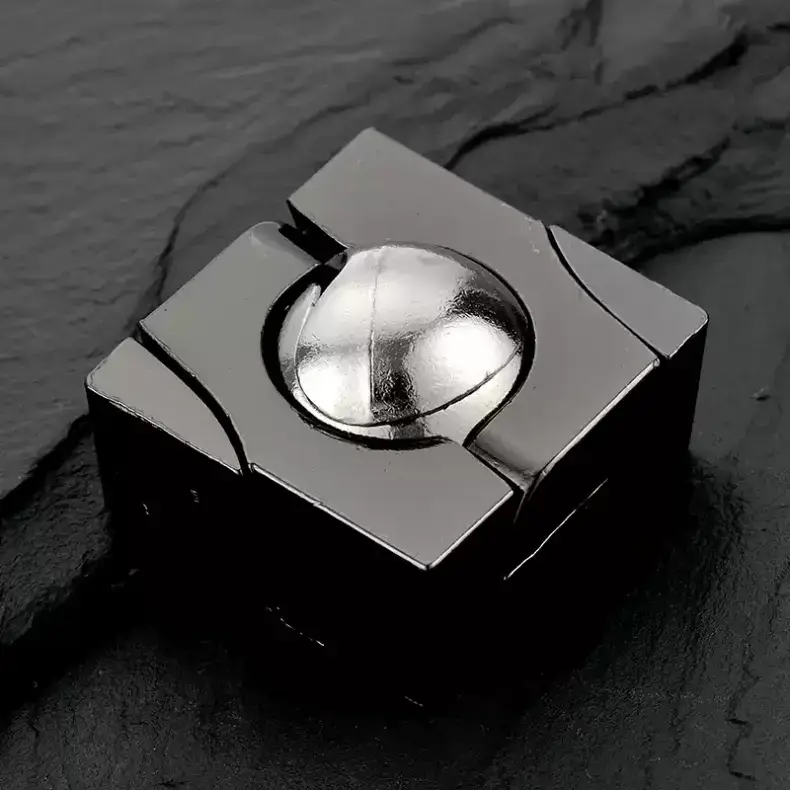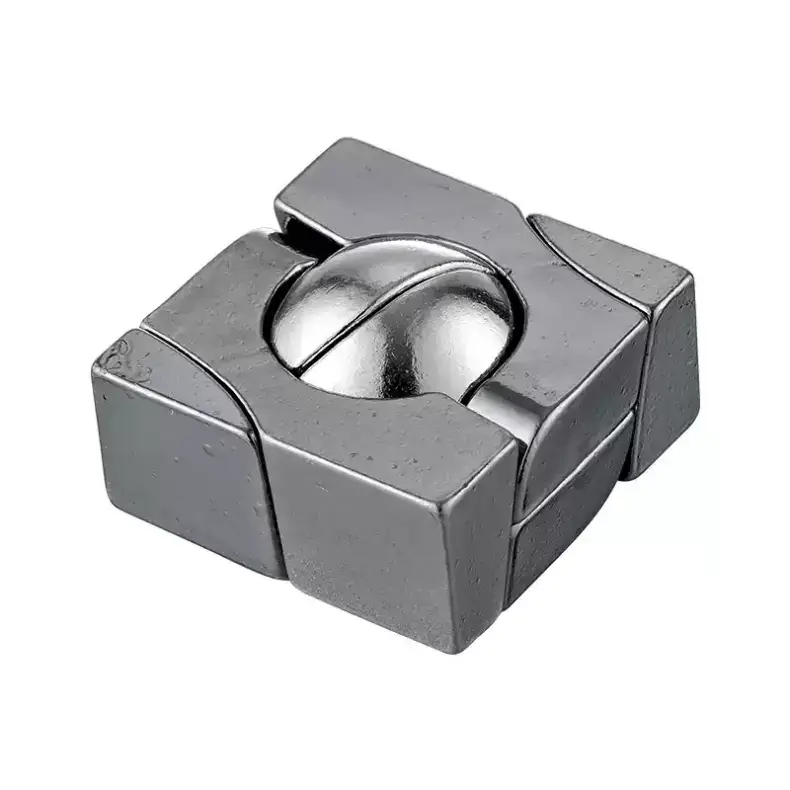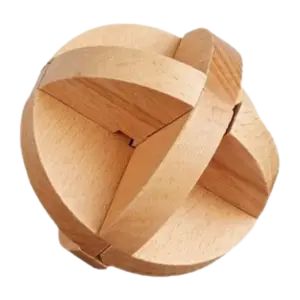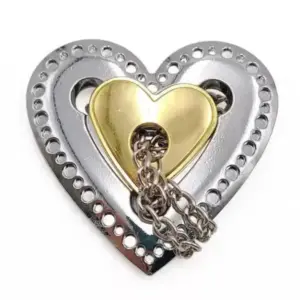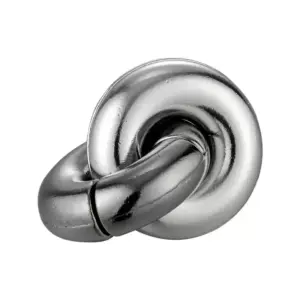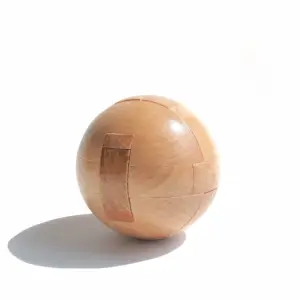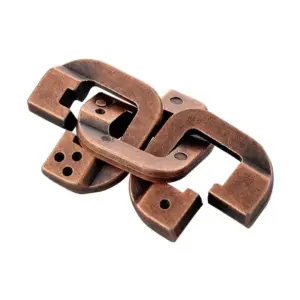The captivating Sphere Morphs Into Cube puzzle represents a paradigm shift in the mechanical puzzle landscape, ingeniously combining spatial transformation with cognitive challenge. This extraordinary creation defies conventional understanding by enabling a seamless metamorphosis between spherical and cubic forms through cleverly engineered components. More than merely a diversion, this puzzle embodies the intersection of artistic design, mathematical principles, and tactile satisfaction, offering both novices and seasoned enthusiasts a multifaceted experience that transcends traditional puzzle boundaries. The following comprehensive guide illuminates the mechanics, techniques, and profound cognitive benefits of this remarkable innovation that has rapidly ascended to prominence within puzzle-collecting communities worldwide.
The Ingenious Architecture Behind Sphere Morphs Into Cube
Fundamental Design Principles
The Sphere Morphs Into Cube distinguishes itself through a meticulous engineering approach that belies its deceptively simple appearance. At its core, the puzzle consists of four distinct modules that interlock with remarkable precision to form a flawless cube while concealing a dynamic sphere inside. This architectural marvel represents a significant evolution from conventional mechanical puzzles, incorporating principles of modular design that enable its dramatic transformation capabilities. The interplay between the external cubic structure and the internal spherical element creates a fascinating tension that challenges spatial perception and manual dexterity simultaneously.
Each component of the puzzle has been crafted with exceptional attention to detail, featuring precision-cut edges and interlocking mechanisms that ensure smooth operation while maintaining structural integrity. The designers have clearly drawn inspiration from classical challenges like the Rubik’s Cube and traditional Luban Lock, yet they’ve transcended these influences by incorporating contemporary design sensibilities and advanced manufacturing techniques. This fusion of traditional puzzle concepts with modern engineering creates an object that feels both familiar and revolutionary—a rare achievement in the increasingly saturated puzzle market.
The materials selected for the Sphere Morphs Into Cube further enhance its appeal, with high-quality constituents that provide optimal tactile feedback during manipulation. This thoughtful material selection contributes significantly to the overall experience, as the weight, texture, and responsiveness of the puzzle components directly impact the solver’s engagement and satisfaction. The visual aesthetic complements this tactile experience, with clean lines and balanced proportions that make the puzzle as pleasing to observe as it is to handle.
Geometric Transformation Mechanics
The truly revolutionary aspect of the Sphere Morphs Into Cube lies in its transformation mechanism. Unlike static puzzles that maintain a consistent form throughout the solving process, this creation undergoes a complete metamorphosis that challenges fundamental assumptions about three-dimensional objects. The process begins with the assembly of a perfect sphere from two hemispheres—a seemingly straightforward task that establishes a false sense of simplicity. This sphere must then somehow inhabit a cubic space through a sequence of movements that initially appears physically impossible.
The transformation process requires a sophisticated understanding of spatial relationships. Users must first split both the ball and cube into their respective halves, then execute a precise sequence of movements: sliding one half of the ball into one part of the cube, positioning the other half into the remaining cubic section, aligning the cube pieces with a slight offset, and finally twisting them 180 degrees in opposite directions. This counterintuitive sequence results in the complete encapsulation of the sphere within the cube structure, with the added surprise that the assembled puzzle functions as a spinning top.
This geometric transformation exemplifies mathematical principles at work in physical form, creating an object that seems to defy conventional Euclidean geometry. The puzzle thereby offers a tangible exploration of topological concepts that might otherwise remain abstract to most people. This blend of intellectual challenge and physical manipulation creates a uniquely satisfying experience that distinguishes the Sphere Morphs Into Cube from countless other puzzles on the market.
Mastering the Challenge: A Systematic Approach
Beginner’s Methodology for Initial Success
For newcomers to the Sphere Morphs Into Cube, the initial encounter often produces a mixture of fascination and frustration. The puzzle’s unconventional nature demands a methodical approach that differs from traditional puzzle-solving strategies. Beginners should first familiarize themselves with the individual components, examining how the four modules interact with one another before attempting the complete transformation. This preliminary exploration establishes critical spatial awareness that will serve as the foundation for more complex manipulations.
A productive starting strategy involves breaking down the transformation process into distinct phases rather than attempting the complete metamorphosis in one continuous effort. Begin by practicing the assembly of the perfect sphere, ensuring that the hemispheres align precisely along their edges. Once comfortable with this basic operation, transition to exploring the cubic formation independently, understanding how the cubic modules interlock to create a stable three-dimensional structure. This segmented approach reduces cognitive overload and allows for incremental mastery of the puzzle’s mechanics.
Sphere Morphs Into Cube
Sphere Morphs Into Cube – The Ultimate Puzzle Challenge
- Innovative Design: A mind-bending puzzle toy that transforms four interlocking modules into a perfect cube with a hidden moving sphere.
- Engaging Challenge: Combines the allure of traditional brain teasers like the Rubik’s Cube and Luban Lock with modern, creative twists.
- Enhances Cognitive Skills: Boosts spatial reasoning, problem-solving, and motor skills for all ages.
- Premium Quality: Crafted with precision engineering and durable materials for endless hours of fun.
- Perfect Gift: Ideal for puzzle enthusiasts, educators, and anyone seeking a unique, challenging experience.
Common beginner mistakes include applying excessive force during the transformation process or attempting to rush through the sequence without properly aligning the components. The Sphere Morphs Into Cube requires precision rather than strength—a gentle touch and patient manipulation yield far better results than forceful movements. Additionally, many novices struggle with the conceptual leap of encapsulating a sphere within a cube of seemingly insufficient volume. This mental barrier can be overcome by focusing on the process rather than fixating on the apparent impossibility of the final configuration.
Advanced Techniques for Optimization
As solvers gain proficiency with the basic transformation sequence, they can begin refining their technique to achieve greater efficiency and elegance. Advanced practitioners develop a smooth, almost choreographed sequence of movements that transforms the puzzle with minimal hesitation or adjustment. This level of mastery requires developing muscular memory for the precise angles and rotations necessary at each stage of the transformation process.
Finger positioning becomes increasingly important at advanced levels, with experienced puzzlers utilizing specific grip techniques that maximize control while minimizing unnecessary movement. The optimal approach involves maintaining contact with multiple components simultaneously, allowing for subtle adjustments throughout the transformation sequence. This technique reduces the need for repositioning hands or transferring the puzzle between palms, resulting in a more fluid and aesthetically pleasing solving experience.
The most sophisticated practitioners can perform the complete transformation cycle—from sphere to cube and back again—in a continuous, seamless motion that appears almost magical to observers. This level of mastery transcends mere puzzle-solving and approaches performance art, with the solver demonstrating complete command over the physical properties and geometric principles embodied in the Sphere Morphs Into Cube. Achieving this caliber of expertise typically requires hundreds of repetitions and a deep intuitive understanding of the puzzle’s internal mechanics.
Cognitive Benefits and Educational Value
Enhancing Spatial Intelligence Through Puzzle Interaction
The Sphere Morphs Into Cube offers substantial cognitive benefits that extend far beyond entertainment value. Primarily, the puzzle serves as an exceptional tool for developing spatial intelligence—the ability to visualize and manipulate three-dimensional objects mentally. This cognitive skill has been linked to success in numerous fields, including architecture, engineering, mathematics, and even surgical medicine. Regular engagement with complex spatial puzzles like the Sphere Morphs Into Cube strengthens neural pathways associated with visual-spatial processing, potentially enhancing performance in related academic and professional contexts.
Research in cognitive psychology suggests that manipulating physical objects that transform between distinct geometric states exercises mental flexibility and promotes adaptive problem-solving strategies. The Sphere Morphs Into Cube is particularly valuable in this regard, as it requires solvers to reconcile seemingly contradictory spatial relationships—a sphere contained within a cube of comparable dimensions. This cognitive dissonance compels the brain to develop more sophisticated mental models of three-dimensional space, expanding conceptual frameworks that may have become rigid through conventional education or experience.
Educational institutions have increasingly recognized the value of incorporating tactile puzzles like the Sphere Morphs Into Cube into STEM curricula. The puzzle provides a concrete manifestation of abstract mathematical concepts, making principles of topology, geometry, and mechanical engineering accessible to visual and kinesthetic learners who might struggle with purely theoretical presentations. The transformation process illustrates complex spatial relationships in a tangible format that students can directly experience rather than merely visualize, creating powerful learning moments that often generate spontaneous insights.
Psychological Benefits Beyond Cognition
Beyond its intellectual challenges, the Sphere Morphs Into Cube offers notable psychological benefits that contribute to overall wellbeing. The focused attention required to solve the puzzle induces a state similar to mindfulness meditation, temporarily suspending concerns about past or future in favor of complete engagement with the present moment. This absorption in a challenging yet manageable task creates what psychologists term “flow state”—a condition of optimal experience characterized by deep concentration, intrinsic motivation, and a distorted sense of time.
Regular engagement with mechanical puzzles has been associated with reduced stress levels and improved mood regulation. The Sphere Morphs Into Cube provides an especially effective stress-relief mechanism due to its satisfying tactile qualities and the dramatic transformation that rewards persistent effort. Many enthusiasts report a profound sense of accomplishment upon successfully completing the sphere-to-cube transformation, triggering a release of dopamine that reinforces positive associations with intellectual challenges. This neurochemical reward system encourages continued engagement with similar cognitive tasks, potentially establishing beneficial habits of mental exercise.
For individuals struggling with anxiety or intrusive thoughts, the puzzle offers a productive redirection of mental energy. The complex manipulation sequence demands complete focus, temporarily displacing worrisome ruminations and creating a cognitive respite from psychological distress. While not a replacement for professional mental health interventions, puzzles like the Sphere Morphs Into Cube can serve as valuable complementary tools in comprehensive approaches to psychological wellbeing, particularly for individuals who respond positively to tactile stimulation and structured problem-solving activities.
The Cultural Phenomenon and Community Development
Rising Popularity in Digital and Physical Spaces
The Sphere Morphs Into Cube has transcended its identity as a mere puzzle to become a genuine cultural phenomenon, with rapidly expanding visibility across digital platforms and physical retail spaces. Social media algorithms have amplified this growth, with hashtags related to the puzzle regularly trending across platforms like Instagram, TikTok, and YouTube. Content creators have produced thousands of videos showcasing solving techniques, creative modifications, and reactions to the puzzle’s surprising transformation, collectively generating millions of views and creating a virtuous cycle of increased awareness and demand.
Google Trends data confirms substantial search interest in terms like “mechanical puzzles,” “brain teasers,” and specifically “Sphere Morphs Into Cube,” with notable spikes corresponding to viral content featuring the puzzle. This digital prominence has translated into tangible market impact, with retailers reporting consistent demand and frequent stock shortages as puzzle enthusiasts and curious newcomers alike seek to experience the transformation firsthand. The puzzle has particularly resonated with demographics that traditionally might not identify as puzzle collectors, broadening the appeal of mechanical puzzles beyond established niche communities.
Celebrity endorsements and appearances in mainstream media have further cemented the puzzle’s cultural relevance. Several high-profile intellectuals, entertainers, and influencers have showcased the Sphere Morphs Into Cube in various contexts, from casual social media posts to structured interviews discussing cognitive development and innovative design. This mainstream exposure has introduced the puzzle to audiences who might otherwise never encounter specialty mechanical puzzles, substantially expanding its cultural footprint and commercial viability.
Building Community Through Shared Challenge
Around the Sphere Morphs Into Cube has emerged a vibrant community of enthusiasts who connect through shared appreciation of the puzzle’s elegant complexity. Online forums dedicated to mechanical puzzles have developed specific subgroups focused on transformation puzzles, with the Sphere Morphs Into Cube frequently serving as a centerpiece for discussion. These communities facilitate knowledge exchange, problem-solving assistance, and celebration of achievements, creating social bonds through mutual interest in spatial challenges and mechanical ingenuity.
Puzzle cafés and specialized retail environments increasingly feature the Sphere Morphs Into Cube as a conversation starter and community-building tool. These physical spaces allow enthusiasts to gather, demonstrate techniques, and introduce newcomers to the satisfactions of mechanical puzzle-solving in a supportive environment. The shared experience of mastering the transformation creates instant rapport between strangers, fostering connections that frequently evolve into lasting friendships centered on similar intellectual interests.
Competitive events centered around speed-solving the Sphere Morphs Into Cube have emerged in several countries, ranging from informal local gatherings to structured tournaments with standardized rules and timing systems. These competitions provide additional motivation for skill development while strengthening community bonds through friendly rivalry. Particularly accomplished solvers have achieved minor celebrity status within these communities, often sharing advanced techniques through workshops or online tutorials that help others improve their abilities and deepen their appreciation for the puzzle’s sophisticated design.
Creative Applications and Future Developments
Customization and Artistic Expressions
The Sphere Morphs Into Cube has inspired remarkable creativity beyond its intended purpose, with enthusiasts developing custom modifications that enhance both aesthetic appeal and functional complexity. Skilled artisans have created limited-edition versions featuring exotic woods, precious metals, and custom engravings that transform the puzzle into collectible art objects while maintaining full functionality. These bespoke creations often command premium prices among collectors who appreciate both the mechanical ingenuity and artistic craftsmanship embodied in these specialized variants.
Digital designers have developed numerous 3D-printable modifications that alter the puzzle’s characteristics in fascinating ways. These variations include adjusted tolerances for different skill levels, alternative geometric configurations that change the transformation process, and decorative elements that personalize the experience without compromising functionality. The open-source nature of many of these designs has democratized access to custom versions, allowing enthusiasts with access to 3D printing technology to experiment with modifications regardless of geographical location or economic resources.
Some particularly creative individuals have incorporated the Sphere Morphs Into Cube into larger artistic installations exploring themes of transformation, perception, and dimensional thinking. These works contextualize the puzzle within broader philosophical frameworks, using its physical metamorphosis as a metaphor for conceptual transformations in scientific paradigms, personal development, or social evolution. This artistic appropriation further demonstrates the puzzle’s cultural significance beyond its primary identity as an entertainment object or cognitive challenge.
Emerging Trends and Innovations
The success of the Sphere Morphs Into Cube has catalyzed innovation throughout the mechanical puzzle industry, with designers and manufacturers pursuing new concepts that build upon its transformation principles. Recent developments include puzzles that morph between multiple geometric states, integrated electronic components that respond to successful transformations, and hybrid designs that combine features of different puzzle categories. This wave of innovation has revitalized interest in mechanical puzzles broadly, attracting investment and entrepreneurial activity to a market segment previously considered relatively niche.
Material science advances are enabling the next generation of transformation puzzles, with manufacturers experimenting with shape-memory alloys, programmable materials, and advanced composites that offer unprecedented mechanical properties. These materials create possibilities for puzzles that transform in response to temperature changes, applied pressure, or specific sequences of movements, potentially creating entirely new categories of physical puzzles that transcend traditional limitations of fixed materials and structures.
Augmented reality applications have begun to complement physical puzzles like the Sphere Morphs Into Cube, with smartphone apps that visualize internal mechanisms during manipulation or provide interactive tutorials for struggling solvers. These digital companions enhance the physical experience without replacing it, creating a hybrid engagement that combines tactile satisfaction with informational richness. Future developments will likely further integrate digital and physical interactions, potentially including puzzles with embedded sensors that communicate with digital interfaces to create gamified experiences or educational activities.
Conclusion:
The Enduring Appeal of Transformative Challenges
The Sphere Morphs Into Cube represents significantly more than a novelty item or temporary diversion—it embodies timeless principles of human curiosity, problem-solving drive, and aesthetic appreciation that have characterized puzzle engagement throughout history. The puzzle’s elegant transformation between distinct geometric states creates a moment of genuine wonder that connects contemporary solvers with ancient traditions of mechanical ingenuity, from Chinese wooden puzzle boxes to Renaissance mathematical recreations. This historical continuity suggests that despite rapidly changing technological landscapes, the fundamental human attraction to tactile challenges and spatial transformation remains remarkably constant.
The puzzle’s enduring appeal derives from its perfect balance between accessibility and complexity. Initial engagement requires no specialized knowledge or abilities, making the puzzle approachable for virtually anyone with basic manual dexterity. Yet the transformation process contains sufficient subtlety and counterintuitive elements to maintain interest through dozens or even hundreds of repetitions, as solvers continually refine their technique and develop deeper appreciation for the mechanical principles involved. This combination of low entry barriers and high skill ceilings creates an unusually inclusive cognitive challenge that appeals across diverse demographic categories.
For those willing to accept its invitation to exploration, the Sphere Morphs Into Cube offers far more than entertainment—it provides a gateway to enhanced spatial thinking, moments of meditative focus, and connection with a global community of like-minded enthusiasts. Whether approached as casual diversion, serious cognitive exercise, or collectible art object, this remarkable puzzle continues to capture imagination and reward persistence in equal measure. In a world increasingly dominated by digital experiences, the tangible transformation from sphere to cube represents a refreshing return to physical interaction and concrete problem-solving that resonates with fundamental human cognitive preferences and perceptual capacities.

